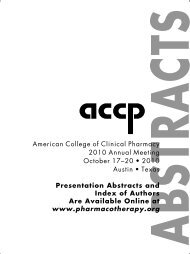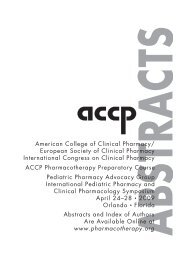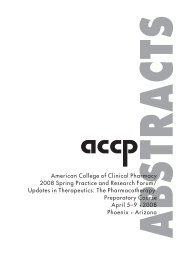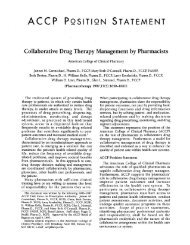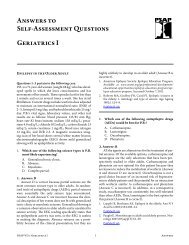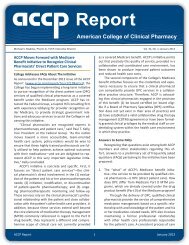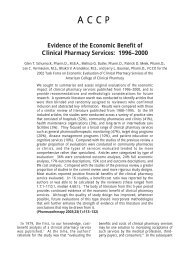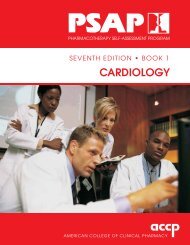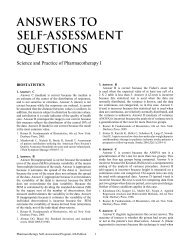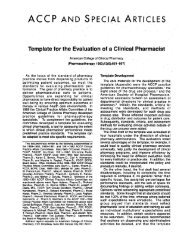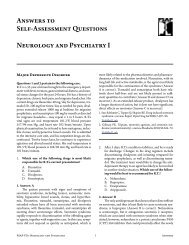Answers to Self-Assessment Questions - ACCP
Answers to Self-Assessment Questions - ACCP
Answers to Self-Assessment Questions - ACCP
Create successful ePaper yourself
Turn your PDF publications into a flip-book with our unique Google optimized e-Paper software.
the PN solution daily. Having a caregiver, other than the<br />
patient, <strong>to</strong> care for the CVAD and manage the PN infusion<br />
(Answer D) would be helpful for all patients, but it is not<br />
necessary before discharge because most patients can do<br />
these functions; thus Answer D is not the best answer.<br />
1. Siepler J. Principles and strategies for moni<strong>to</strong>ring home<br />
parenteral nutrition. Nutr Clin Prac 2007;22:340–50.<br />
2. Kovacevich DS, Frederick A, Kelly D, Nishikawa RA, Young<br />
L. Standards for specialized nutrition support: home care<br />
patients. Nutr Clin Pract. 2005;20:579–9.<br />
26. Answer: B<br />
A patient with Crohn’s disease and SBS has a tunneled<br />
CVAD for home PN. She has a temperature of 104°F (40°C)<br />
for several days. The most likely cause of her fever is a<br />
CVAD-associated infection (Answer B); thus, Answer B<br />
is the correct answer. Answer A (Crohn’s disease–related<br />
hyperthermia) is possible, but in a patient receiving home<br />
PN through a CVAD, infection is more likely <strong>to</strong> explain her<br />
fever; thus, Answer A is incorrect. Answer C (a systemic<br />
viral infection) is also possible, but a CVAD-associated<br />
infection is more likely with the high fever. Answer D<br />
(hypersensitivity reaction <strong>to</strong> the fat emulsion in the PN) is<br />
incorrect because the patient has been receiving home PN<br />
for several years.<br />
1. Siepler J. Principles and strategies for moni<strong>to</strong>ring home<br />
parenteral nutrition. Nutr Clin Prac 2007;22:340–50.<br />
2. Yildizeli B, Lacin T, Batirel HF, Yuksel M. Complications and<br />
management of long-term central venous access CVADs and<br />
ports. J Vasc Access 2004;5:174–8.<br />
27. Answer: D<br />
A 45-year-old man (weight 75 kg, height 165 cm ) with<br />
SBS (150 cm small bowel and the entire colon remaining)<br />
is receiving 2200 calories only 2 days/week. Answer D<br />
(his PN infusion should be weaned <strong>to</strong> 1 day/week) is the<br />
correct answer. He has had stable weight gain for 3 years,<br />
is well hydrated, and does not need additional hydration<br />
on the days that he does not receive a PN infusion. Thus,<br />
a trial of weaning his PN <strong>to</strong> 1 day/week is appropriate.<br />
Both Answer A (referral <strong>to</strong> an intestinal rehabilitation<br />
program) and Answer B (referral <strong>to</strong> an intestinal transplant<br />
program) are incorrect because it appears that he will be<br />
able <strong>to</strong> wean off PN without additional assistance; his bowel<br />
length is long enough, and he has been able <strong>to</strong> wean <strong>to</strong> only<br />
two PN infusions weekly. It would be desirable <strong>to</strong> attempt<br />
<strong>to</strong> wean him off PN first before referral <strong>to</strong> a rehabilitation<br />
or transplantation program. Answer C (his PN should be<br />
changed <strong>to</strong> a daily infusion of 630 kcal) is incorrect because<br />
he is doing well with hydration using his current twice<br />
weekly regimen, so there is no need <strong>to</strong> go back <strong>to</strong> a daily<br />
infusion.<br />
1. Siepler J. Principles and strategies for moni<strong>to</strong>ring home<br />
parenteral nutrition. Nutr Clin Prac 2007;22:340–50.<br />
2. Messing B, Joly F. Guidelines for management of home<br />
parenteral support in adult chronic intestinal failure patients.<br />
Gastroenterology 2006:130:S43–S51.<br />
3. Jeppesen PB, Mortensen PB. Intestinal failure defined by<br />
measurements of intestinal energy and wet weight absorption.<br />
Gut 2000;46:701–6.<br />
28. Answer: C<br />
A 34-year-old with Crohn’s disease and SBS (25<br />
cm residual small bowel) had a dual-energy x-ray<br />
absorptiometry (DEXA) scan with T scores reported as<br />
lumbosacral spine −3.2 and right femoral neck −3.0. This<br />
patient has osteoporosis with a significant risk of fracture;<br />
thus the best treatment for her is <strong>to</strong> start pamidronate 60<br />
mg intravenously every month (Answer C). Answer A (start<br />
alendronate oral solution 7.5 mg daily) is not the best answer<br />
because alendronate in either the tablet or liquid dosage form<br />
is likely <strong>to</strong> be inadequately absorbed in this patient with<br />
severe SBS. Answer B (discontinue methylprednisolone) is<br />
incorrect because rapidly discontinuing her corticosteroid<br />
treatment is not advisable as it may result in a flare of her<br />
Crohn’s disease. Answer D (do nothing) is not the best<br />
course of action because she will require PN for her lifetime,<br />
and her osteoporosis likely will continue <strong>to</strong> worsen without<br />
treatment.<br />
1. Buchman AL, Moukarzel A. Metabolic bone disease associated<br />
with <strong>to</strong>tal parenteral nutrition. Clin Nutr 2000;19:217–31.<br />
2. Hurley DL, McMahon M. Long term parenteral nutrition and<br />
metabolic bone disease. Endocrinol Metab Clin North Am<br />
1990;19:113–31.<br />
29. Answer: A<br />
A patient receiving home PN is having difficulty aspirating<br />
blood from her CVAD for routine labora<strong>to</strong>ry testing. The<br />
CVAD flushes easily, and she reports no problems with<br />
the PN infusion. This difficulty in withdrawing blood<br />
from the CVAD likely is caused by a thrombus “flap” that<br />
allows infusion of fluid through the CVAD but obstructs<br />
the CVAD lumen when negative pressure is applied in the<br />
process of aspirating blood. Answer A (instill alteplase in<br />
the CVAD <strong>to</strong> attempt <strong>to</strong> clear the obstruction) is the correct<br />
answer. Answer B (do nothing) is incorrect because this<br />
withdrawal occlusion can progress <strong>to</strong> complete occlusion<br />
and should be addressed at this time. Answer C (instill<br />
ethanol 70% <strong>to</strong> dissolve the probable lipid occlusion) is<br />
incorrect because the most likely problem is a thrombus<br />
occlusion, not a lipid occlusion, because the catheter<br />
still flushes well. A lipid plug usually causes a complete<br />
occlusion, not just withdrawal occlusion. Answer D<br />
(have the CVAD removed) is incorrect because alteplase<br />
will likely correct the problem, avoiding CVAD removal.<br />
1. Gould JR, Carlos HW, Skinner WL. Groshong CVAD associated<br />
subclavian CVAD thrombosis. Am J Med 1993;95:419–23.<br />
2. Bern MM, Lokich JJ, Wallach SR, Bothe A Jr, Benotti PN, Arkin<br />
CF, et al. Very low doses of warfarin can prevent thrombosis in<br />
central venous CVADs. A randomized prospective trial. Ann<br />
Int Med 1990;112:4213–28.<br />
30. Answer: D<br />
The most likely cause of W.H.’s weight loss is<br />
dehydration, probably from an increase in his s<strong>to</strong>ol output.<br />
Before any changes in his therapy are made, he should be<br />
questioned <strong>to</strong> determine if his s<strong>to</strong>ol output has increased<br />
during the past week. Answer A (increase the protein and<br />
carbohydrate in his PN formulation <strong>to</strong> stimulate weight<br />
gain) and Answer B (increase the intravenous fat component<br />
of his PN formulation <strong>to</strong> stimulate weight gain) assume<br />
that his weight loss is caused by suboptimal calorie intake.<br />
Pharmacotherapy <strong>Self</strong>-<strong>Assessment</strong> Program, 6th Edition 41 Gastroenterology and Nutrition <strong>Answers</strong>



